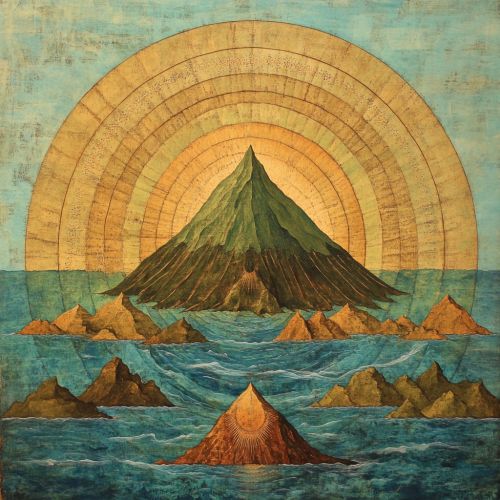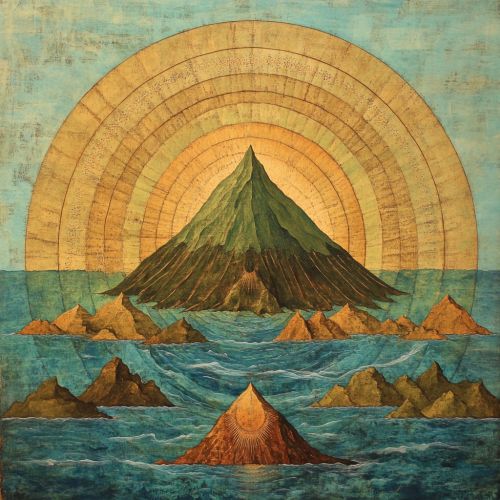Mount Meru
Introduction
Mount Meru is a prominent and sacred mountain in Hindu, Jain, and Buddhist cosmology. It is considered the center of all physical, metaphysical, and spiritual universes. This article delves into the various aspects of Mount Meru, including its religious significance, geographical representation, and its influence on culture and architecture.
Religious Significance
Mount Meru holds a central place in Hindu cosmology. It is described as the axis mundi, the world axis, around which the universe revolves. According to Hindu texts, Mount Meru is surrounded by seven concentric ranges of mountains and oceans, each with its own unique characteristics. The mountain itself is said to be 84,000 yojanas high, with its summit reaching into the heavens.
In Hinduism, Mount Meru is often depicted as the abode of gods, particularly Indra, the king of the gods. It is also considered the home of Brahma, the creator god, and other deities. The mountain is often associated with the concept of Kailash, another sacred mountain in Hindu tradition.
In Jainism, Mount Meru is also of great importance. It is considered the center of the universe and is surrounded by various regions inhabited by different beings. The mountain is often depicted in Jain cosmological diagrams and is considered the abode of the Tirthankaras, the spiritual teachers of Jainism.
In Buddhism, Mount Meru is known as Sumeru or Sineru. It is considered the center of the physical, metaphysical, and spiritual universes. The mountain is often depicted in Buddhist cosmological texts and is considered the abode of various gods and celestial beings.
Geographical Representation
Mount Meru is often depicted in ancient texts and artworks, but its exact geographical location remains a subject of debate among scholars. Some believe that Mount Meru is a mythical mountain, while others suggest that it may have a real-world counterpart.
One theory suggests that Mount Meru is located in the Himalayas, specifically in the region of Kailash. Mount Kailash is considered a sacred mountain in Hinduism, Jainism, and Buddhism, and shares many characteristics with Mount Meru. Another theory suggests that Mount Meru may be located in the Pamirs, a mountain range in Central Asia.
Despite the lack of a definitive geographical location, Mount Meru continues to be a significant symbol in various religious traditions. Its depiction in ancient texts and artworks serves as a reminder of its importance in the spiritual and metaphysical realms.


Cultural Influence
Mount Meru has had a profound influence on the culture and architecture of various regions. In Hindu and Buddhist temples, the central spire or tower is often designed to represent Mount Meru. This architectural feature is known as the Shikhara in Hindu temples and the Stupa in Buddhist temples.
In Angkor Wat, the famous temple complex in Cambodia, the central tower is designed to represent Mount Meru. The temple complex itself is surrounded by a series of concentric galleries, symbolizing the mountain ranges and oceans that surround Mount Meru.
In Borobudur, a Buddhist temple in Indonesia, the central stupa is designed to represent Mount Meru. The temple is built in the form of a mandala, with concentric terraces representing the mountain ranges and oceans that surround Mount Meru.
Mount Meru also appears in various myths and legends. In Hindu mythology, it is said that the Samudra Manthan, the churning of the ocean of milk, took place around Mount Meru. In this myth, the gods and demons used the mountain as a churning rod to extract the nectar of immortality from the ocean.
Scientific Interpretations
While Mount Meru is primarily a religious and mythological concept, some scholars have attempted to interpret it from a scientific perspective. One theory suggests that Mount Meru may represent a cosmic axis or a central point in the universe. This theory is supported by the fact that many ancient cultures, including the Greeks and the Egyptians, had similar concepts of a central axis or world tree.
Another theory suggests that Mount Meru may represent a geological feature, such as a volcano or a mountain range. This theory is supported by the fact that many ancient texts describe Mount Meru as a towering mountain with a golden peak, which could be interpreted as a volcanic eruption.
Despite these scientific interpretations, Mount Meru remains primarily a religious and mythological concept. Its significance lies in its symbolic representation of the center of the universe and its role as the abode of gods and celestial beings.
